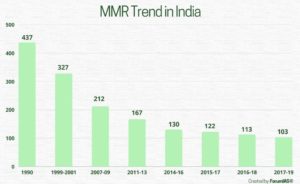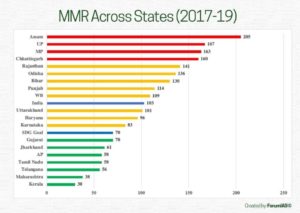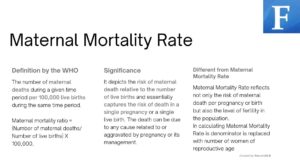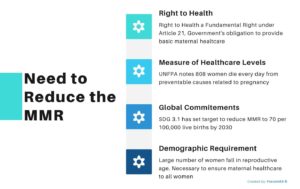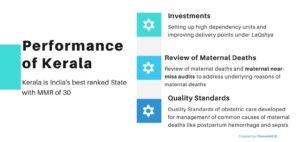ForumIAS announcing GS Foundation Program for UPSC CSE 2025-26 from 19 April. Click Here for more information.
Contents
- 1 Introduction
- 2 What is the Maternal Mortality Ratio (MMR)?
- 3 What is the status of MMR in India?
- 4 What is the status of MMR across the globe?
- 5 What is the need to focus on reducing the MMR?
- 6 What initiatives have been taken by the government to reduce MMR?
- 7 What are the major challenges in improving the MMR?
- 8 What are the reasons behind Kerala’s good performance?
- 9 What should be the approach going ahead?
- 10 Conclusion
| For 7PM Editorial Archives click HERE → |
Introduction
The Maternal Mortality Ratio (MMR) in India has declined by 10 points as per a special bulletin released by the Registrar General of India. It has declined from 113 in 2016-18 to 103 in 2017-19 (8.8 % decline). This is a laudable achievement considering the relevance of MMR in determining the status of maternal health in the country. The data show that India is on the right path to meet its sustainable development goal with respect to MMR. However there is a need to focus on poor performing states like U.P, Assam. Chhattisgarh and West Bengal etc. and address the impediments that curtail an improvement of MMR.
What is the Maternal Mortality Ratio (MMR)?
Maternal mortality refers to deaths due to complications during pregnancy and childbirth. The WHO defines Maternal Mortality Ratio as the number of maternal deaths during a given time period per 100,000 live births during the same time period. It depicts the risk of maternal death relative to the number of live births and essentially captures the risk of death in a single pregnancy or a single live birth. The death can be due to any cause related to or aggravated by pregnancy or its management.
Measurement requires information on pregnancy status, timing of death (during pregnancy, childbirth, or within 42 days of termination of pregnancy), and cause of death.
Maternal mortality ratio = (Number of maternal deaths / Number of live births) X 100,000.
The maternal mortality ratio should not be confused with the maternal mortality rate (whose denominator is the number of women of reproductive age), which reflects not only the risk of maternal death per pregnancy or birth but also the level of fertility in the population.
The maternal mortality ratio (whose denominator is the number of live births) indicates the risk once a woman becomes pregnant, thus does not take fertility levels in a population into consideration.
What is the status of MMR in India?
India has witnessed a progressive reduction in the MMR from 130 in 2014-2016, 122 in 2015-17, 113 in 2016-18, and to 103 in 2017-19.
The persistent decline shows that India is on the verge of achieving the National Health Policy (NHP) target of 100/lakh live births. India is also on track to achieve the Sustainable Development Goal (SDG) target of 70/ lakh live births by 2030.
The number of States that have achieved the SDG target has now risen from five to seven — Kerala (30), Maharashtra (38), Telangana (56), Tamil Nadu (58), Andhra Pradesh (58), Jharkhand (61), and Gujarat (70).
There are now nine States that have achieved the MMR target set by the NHP, which include the above seven and Karnataka (83) and Haryana (96).
Uttarakhand (101), West Bengal (109), Punjab (114), Bihar (130), Odisha (136) and Rajasthan (141) have the MMR in between 100-150.
Chhattisgarh (160), Madhya Pradesh (163), Uttar Pradesh (167) and Assam (205) have the MMR above 150.
What is the status of MMR across the globe?
From 2000 to 2017, the global maternal mortality ratio declined by 38% (from 342 deaths to 211 deaths per 100,000 live births) according to UN inter-agency estimates. This translates into an average annual rate of reduction of 2.9%.
While substantive, this is less than half the 6.4% annual rate needed to achieve the Sustainable Development global goal of 70 maternal deaths per 100,000 live births.
Between 2000 and 2017, South Asia achieved the greatest overall percentage reduction in MMR, with a reduction of 59% (from 395 to 163 maternal deaths per 100,000 live births). Sub-Saharan Africa achieved a substantial reduction of 39% of maternal mortality during this period.
What is the need to focus on reducing the MMR?
Right to Health: The Supreme Court in various judgements (like Bandhua Mukti Morcha Case) has recognized that Right to Health is a fundamental right under Article 21 of the constitution. It is necessary to live a meaningful and dignified life. Therefore the State has the responsibility provide requisite health care from womb to tomb.
Barometer of Healthcare systems: The MMR reflects the capacity of the health systems to provide effective health care in preventing and addressing the complications occurring during pregnancy and childbirth. According to the United Nations Population Fund (UNFPA) approximately 808 women die every day from preventable causes related to pregnancy and childbirth. For every woman who dies, an estimated 20 or 30 encounter injuries, infections or disabilities. Most of these deaths and injuries are entirely preventable.
Demographic Compulsions: India is a country with more than 1.3 billion people and has the largest working age population in the world. This young workforce falls in reproductive age and requires good quality maternal care.
Global Commitments: India is a signatory to various international commitments like UDHR, UN SDGs etc. which specifically calls for providing quality healthcare to all people including mothers e.g., SDG 3.1 aims to reduce maternal mortality to less than 70 deaths per 100,000 live births.
| Read More: [Kurukshetra February Summary] Maternal and Child Health – Explained, pointwise |
What initiatives have been taken by the government to reduce MMR?
LaQshya (Labour room Quality improvement Initiative): The initiative aims at improving the quality of care in the labour room and maternity Operation Theatre (OT) in public health facilities. Under the initiative, a multi-pronged strategy has been adopted which includes: (a) Improving infrastructure up-gradation; (b) Ensuring availability of essential equipment; (c) Providing adequate human resources; (d) Capacity building of health care workers; (e) Improving quality processes in the labour room.
Pradhan Mantri Matru Vandana Yojana (PMMVY): It is a maternity cash incentive scheme to provide conditions for safe delivery and nutrition practices. It is implemented in all the districts of the country in accordance with the provision of the National Food Security Act, 2013.
Under the Scheme, Pregnant Women and Lactating Mothers (PW&LM) receive a direct cash benefit transfer of Rs. 5,000 in three installments.
Janani Suraksha Yojana (JSY): The National Rural Health Mission’s Janani Suraksha Yojana (JSY) aims to reduce maternal and infant mortality by promoting institutional delivery among pregnant women. Under the scheme, eligible pregnant women are entitled to cash assistance of Rs. 1400 (rural) and Rs. 1000 (urban) in low performing states.
The programme also offers performance-based incentives to ASHA (Accredited Social Health Activist) who promote institutional delivery among pregnant women.
What are the major challenges in improving the MMR?
Lack of Infrastructure: The quality of healthcare infrastructure in tier 3 cities and villages is lacking in several aspects. The healthcare facilities are not equipped with state of art technology equipment and resources like ultrasound machines, testing labs etc. This hinders delivery of quality maternal care to women.
Economic Constraints: As per Tendulkar committee estimates, around 22% of Indians live below the poverty line. The poor women lack access to adequate nourishment during pregnancy which results in complications in pregnancy.
Lack of Skilled personnel: There is shortage of doctors, nurses and other staff especially in rural regions. This hinders regular supervision and timely referral of women to emergency obstetric care when complications are diagnosed.
Education Deficit: A vast majority of the population still resides in rural areas and their lack of education makes them trust more on traditional midwives (birth attendants or dais) in comparison to the modern healthcare system.
Data Discrepancies: There are often data quality problems, particularly related to the underreporting and misclassification of maternal deaths. This gives an improper picture and sometimes enhances or reduces MMR beyond reality.
Social Evils: The existence of child marriage is still very much prevalent in India which results in early pregnancy which can’t be handled by many young girls resulting in their deaths. Similarly, the obsession for having the desired number of male children results in more and more pregnancy cycles even in old age that adversely impacts maternal health.
| Read More: Child marriage in India |
What are the reasons behind Kerala’s good performance?
First, Kerala has made substantial investments in setting up high dependency units in every district and in improving 39 delivery points under the Union Health Ministry’s LaQshya initiative.
Second, the Confidential Review of Maternal Deaths (an initiative by the Kerala Health Department since 2004-05) laid the foundation for all maternal health improvement initiatives. This initiative was further strengthened by maternal near-miss audits in all districts, to analyze the critical events which nearly resulted in maternal deaths.
Third, it developed the Quality Standards in Obstetric Care in 2012-13 to focus on the management of some of the common causes of maternal deaths — postpartum hemorrhage (PPH), pregnancy-induced hypertension (PIH), sepsis and amniotic fluid embolism.
What should be the approach going ahead?
First, the States should cooperate with each other and share the best practices amongst themselves in the spirit of cooperative federalism. For instance, U.P, M.P and Assam can learn a lot from the success of Kerala.
Second, there was a slight jump in number of deaths due to the disruptions caused by the COVID-19 pandemic. MMR might also rise a bit in future. The focus has to be on the strengthening the capacity of the healthcare systems so that the progress made is not lost due to external shocks.
Third, the government should adjust for underreporting and misclassification of deaths and model-based estimates in the cases where data are not reliable. This is required to help the UN Maternal Mortality Estimation Interagency Group (MMEIG). It is composed of WHO, UNICEF, UNFPA, the United Nations Population Division, and the World Bank Group. The MMEIG is tasked with generating internationally comparable estimates of maternal mortality for the purposes of global monitoring.
Fourth, the government should provide greater incentives to ASHA workers who can lure the masses towards the modern healthcare setup. Further, the government can enter into agreements with private medical colleges and induce greater numbers of doctors to serve in rural regions.
Fifth, flagship schemes like Beti Bachao Beti Padhao should be duly implemented to tackle the education deficit and curb the occurrence of social evils.
Conclusion
The Government needs to augment the overall ecosystem of maternal health in order to enable a further reduction in maternal mortality ratio. Mothers should be given due care and support during their journey of motherhood as it is the greatest and hardest thing to do in the world.
Summary in Graphics

